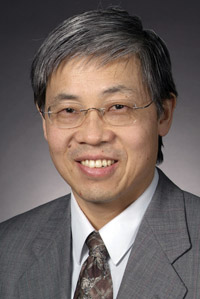by Thane Himes
High-performance semiconductors are individually tested to guarantee quality before they can be shipped to customers. This is done by inputting precisely known data values into a part, and measuring how the part responds to the input data. As Moore’s law continues to push up performance and push down prices, test time has become a significant part of the semiconductor manufacturing cost. For certain high performance parts, the test cost can be as high as 75-percent of the overall cost of build.
“We use high-performance semiconductors for things like medical instruments and defense applications, so when you test these parts, you want the tests to be very accurate, in both the total

value and in the small increments,” says Degang Chen, professor of electrical and computer engineering. “This roughly corresponds to integral non-linearity (INL) and differential non-linearity (DNL).”
The INL and DNL test is the most time consuming among the many parameters to be tested. Many researchers from both academia and industry have been working on various methods to reduce INL/DNL test time. After years of trying various ideas, Chen and graduate student June Yu developed a new algorithm for an analog-to-digital INL/DNL test that is hundreds of times faster and far more precise than the current test method, known as the standard histogram test.
“The standard histogram test has two hidden, gross inefficiencies,” Chen said. “The first is that it treats all the hundreds of thousands of INL/DNL errors as independent random quantities, whereas in reality they are all determined by the much smaller number of circuit components. Also, the most precise quantity in the INL/DNL test setup is the input source, but the standard histogram test throws away the input information.”
Through innovative use of statistical signal processing and system identification, Chen’s new algorithm effectively removed these two gross inefficiencies, thus greatly reducing test time while improving test accuracy.
Chen submitted his findings to the IEEE International Test Conference, but his paper was rejected because his results were deemed “unbelievable.” This led Chen to contact Texas Instruments for further testing. Chen allowed TI to try the technology, hoping that their findings would provide credibility to the “unbelievable” results.
At the invitation of the chief technologist of the company’s High Performance Analog division, Chen went to Texas Instruments last summer after collaborating with them via email during the spring 2011 semester.
“After seeing the initial measurement data, they thought the algorithm had great potential, and they asked me to come down,” Chen said. “I was there for about eight weeks to teach them the new algorithm and help their engineers to implement and validate the algorithm.”
Chen was successful. His algorithm was significantly more precise than the standard histogram tests that use 64 to 256 times more data than Chen’s algorithm required. Since test time is dominantly data acquisition time, the new method was much faster.
“Our method takes about 0.4-percent of the original test time, and our result is more accurate,” Chen said.
One of the ways Chen validated his algorithm’s accuracy was by using the servo loop method, a method that is very accurate but takes a very long time to conduct. Using the servo loop method to test a high-performance 16-bit SAR ADC took 18 minutes. Using Chen’s new algorithm, the same test was finished in less than one-tenth of a second, and the test results matched those from the servo loop extremely well.
The next step for Chen’s research is to introduce the new algorithm to technology producers in the industry. At first, Chen believed that demonstrating the efficiency of his method and getting companies to adopt it would take a great deal of time.
“Technology adoption is a serious matter and involves a pretty slow process,” Chen said. “It will probably take more than a year.”
Chen’s algorithm didn’t need a year. After an additional series of statistical evaluations, Texas Instruments has now adopted Chen’s testing method as standard procedure in several of their product groups, including touch screen technology. This is a giant step forward in the right direction for Chen, who believes that it’s only a matter of time before other companies adopt the method as well.
“Once one company adopts the new algorithm and shows good results, others will follow,” Chen said.
Chen plans to return to Texas Instruments periodically to continue working on the project. He also has submitted a new paper with his results to the ITC, and is waiting for a reply.
